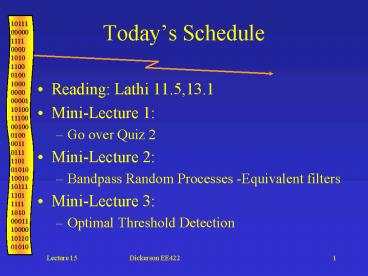Todays Schedule - PowerPoint PPT Presentation
1 / 24
Title:
Todays Schedule
Description:
If the narrow band noise is wide-sense stationary (WSS), then the in-phase and ... Signal is a sinusoid mixed with narrow-band additive white Gaussian noise (AWGN) ... – PowerPoint PPT presentation
Number of Views:110
Avg rating:3.0/5.0
Title: Todays Schedule
1
Todays Schedule
- Reading Lathi 11.5,13.1
- Mini-Lecture 1
- Go over Quiz 2
- Mini-Lecture 2
- Bandpass Random Processes -Equivalent filters
- Mini-Lecture 3
- Optimal Threshold Detection
2
Bandpass Random Process
- What happens to a signal at a receiver? How does
the PSD of the signal after a BPF correspond to
the signal before the BPF?
Sx(w)
-wc
w
wc
0
3
BPF System
- Bandpass random process can be written as
- With the impulse response
cos(wctq)
2cos(wctq)
xc(t)
Ideal LPF H0(w)
x
x
x(t)
x(t)
sin(wctq)
2sin(wctq)
xs(t)
Ideal LPF H0(w)
x
x
4
Impulse Response
- Impulse Response
- Transfer Function
- So, xc(t) and xs(t) are low-pass random
processes, what else can be deduced? - Assume theta is uniformly distributed phase noise
H0(w)
1
2pB
4pB
H (w)
1
-wc
wc
0
5
PSD of BP Random Processes
- PSD of xc(t) and xs(t)
Sx(w)
-wc
wc
w
Sx(w-wc) Sx(wwc)
LPF
-2wc
w
2wc
0
Sxc(w) or Sxs(w)
w
-2wc
0
2wc
6
Mean and variance of narrowband noise
- In-phase and quadrature components have the same
PSD - In-phase and quadrature components of narrowband
noise are zero-mean - Noise comes original signal being passed through
a narrowband linear filter - Variance of the processes is the same (area
under PSD same)
7
Properties
- If the narrowband noise is Gaussian, then the
in-phase (nI) and quadrature (nQ) are jointly
Gaussian. - If the narrow band noise is wide-sense stationary
(WSS), then the in-phase and quadrature
components are jointly WSS.
8
Cross Correlations
- Definition Cross Correlation
- Definition Jointly Stationary
9
Jointly Stationary Properties
- Properties
- Uncorrelated
- Orthogonal
- Independent if x(t1) and y(t2) are independent
(joint distribution is product of individual
distributions)
10
Activity
- Working with a partner come up with a list of
communications systems that will need bandpass
analysis for performance assessment. - The PSD of a BP white noise process is N/2. What
is the PSD and variance of the in-phase and
quadrature components?
11
Example White noise process
- The PSD of a BP white noise process is N/2. What
is the PSD and variance of the in-phase and
quadrature components?
12
Variance of White Noise Process
- From the SNR calculations, it is clear that
13
Sinusoid in Gaussian Noise
- Signal is a sinusoid mixed with narrow-band
additive white Gaussian noise (AWGN) - Can be written as
14
Example (continued)
- In-phase and Quadrature terms of noise Gaussian
with variance s2 - In a similar transformation to that used for
calculating the dart board example, the joint
density can be found in polar coordinates
15
Marginal Density of E
- Rician Density
- Approaches a Gaussian if Agtgts
16
Digital Communications Systems in Noise
- Analog Comm Goal is to reproduce the waveform
accurately - Figure of Merit output signal to noise ratio
- Digital Communications Goal is to decide which
waveform was transmitted accurately - Figure of Merit Probability of error in making
this decision at the receiver
17
Detection Bipolar Signaling
s(t)
- If 1, send p(t)
- If 0, send p(t)
- Received signal r(t) /- p(t) n(t)
- Optimal threshold?
- Noise is additive, Gaussian noise
Peak Detect and Sample
Detector
n(t)
18
PE Calculations
- P(1/0) prob of detecting a 1 when 0 sent
- P(ngtAp)
- P(0/1) prob of detecting a 0 when 1 sent
- P(nlt-Ap)
19
Bipolar
- Total Error Probability
- If P(1)P(0)0.5
Q(x)
0.5
x
20
Minimize PE
- To minimize PE, must maximize r since Q decreases
monotonically as r increases - Ap is the signal amplitude and sn is the rms
noise. - Goal filter signal to enhance signal and reduce
noise power
21
Linear Filtering
Linear Network h(t) H(f)
x(t)/- p(t)n(t) X(f)
y(t)/- po(t)no(t) Y(f)
- Recall
22
Signal Amplitude
- The goal is maximize
- (same as maximizing r)
/- po(t)no(t)
/- p(t)n(t)
ttm
h(t) H(f)
Threshold Detector
p(t)n(t)
p(t)n(t)
p(t)
p(t)
TS
TS
23
Signal and Noise Calculation
- Signal output
- Output noise power or variance
- So, the ratio becomes
24
Next Time
- Reading Lathi 13.1, 13.2
- Mini-Lecture 1
- Optimum Threshold Detection
- Mini-Lecture 2
- Optimum Binary receivers
- Mini-Lecture 3
- Optimum Binary receivers































